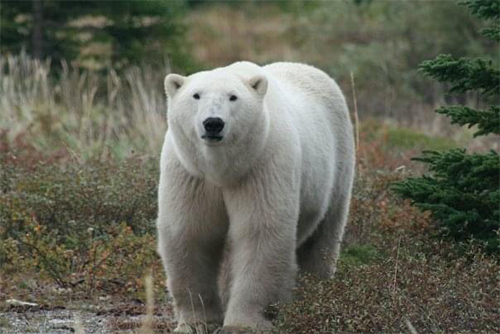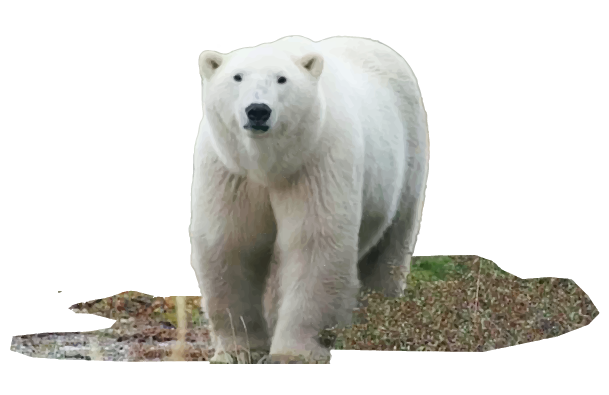Polar Bear

Species information
The following is a report on progress made towards the protection and recovery of Polar Bear, (Ursus maritimus) in Ontario from 2007 to 2020, based on Ontario’s species-specific recovery policy. This report meets the legislative requirement for a review of progress under the Endangered Species Act, 2007 (ESA or “the Act”). Polar Bear is listed as threatened on the Species at Risk in Ontario (SARO) List under the ESA.
Polar Bear has been classified as a species at risk since 2004. It was originally classified as a special concern species and was listed as such under the ESA when it came into force in June 2008.
The species was re-classified as a threatened species on September 10, 2009.
Polar Bear has been protected from being killed, harmed, harassed, captured or taken since 2009.
In addition, the habitat of Polar Bear has been protected from being damaged or destroyed since 2009.
The species-specific recovery policy for Polar Bear, known as the Government Response Statement (GRS) was published in 2016 and includes the government’s recovery goal for the species and the actions and priorities it intends to lead or support to help achieve that goal. The GRS considers science advice provided in the recovery strategy, when developing recovery actions for the species. As legislated in the Act, the purpose of this review is to report on progress made towards implementing the protection and recovery actions in the GRS. The review can also help identify opportunities to adjust and adapt the implementation of protection and recovery actions to achieve the recovery goal for the species.
Further information about Polar Bear, including the threats that it faces, and actions being taken to help protect and recover this species is available on the Government of Ontario webpage for Polar Bear. A summary on the progress towards the protection and recovery of Polar Bear and an annual update on the broader species at risk program (i.e. the Introduction to the 2021 Review of Progress report) is available on the Review of Progress towards the Protection and Recovery of Ontario’s Species at Risk webpage.
Snapshot: Progress toward the protection and recovery of Polar Bear
Progress towards meeting the recovery goal
- The recovery goal in the Government Response Statement (GRS) for Polar Bear in Ontario is to “extend the length of time that the species persists in Ontario to the extent possible, and to collaborate with other jurisdictions, including Indigenous communities and organizations, to increase the likelihood of the species' persistence within Canada”.
- Progress has been made towards implementing all of the government-led and government-supported objectives and a majority of the associated actions. Examples of progress include:
- efforts undertaken in partnership with First Nations communities in the Far North to develop Community Based Land Use Plans and a First Nations led Polar Bear monitoring program
- extensive monitoring efforts undertaken in partnership with educational institutions and other jurisdictions to improve our understanding of the status, distribution, and biology of Polar Bears
- In alignment with the GRS, it is recommended that additional efforts be made to develop, implement, and update, as needed, best management practices to reduce the potential impacts of development activities, such as mineral exploration, on Polar Bears and their habitat.
Occurrences and distribution
- Polar Bear is widely distributed across the northern border of Ontario, with an estimated range of approximately 16,500 square kilometres based on recent observations.
- The Natural Heritage Information Centre (NHIC) has received over 2,400 records of the species based on observations made between 1963 and 2016, the majority of which are from targeted monitoring and surveying efforts.
- Since 2008, the species has been observed in locations where they were not previously known to occur and at locations previously thought to be historical. Based on up-to-date information, the species’ extant distribution is estimated to encompass an area 3,100 square kilometres larger than was known in 2008.
Government-supported stewardship projects:
- Through the Species at Risk Stewardship Program the Government of Ontario has enabled its stewardship partners to conduct four projects (by providing $280,412 in funding) designed to contribute to the protection and recovery of Polar Bear. One of these projects focused exclusively on the species, while the other three projects focused on multiple species at risk, including Polar Bear.
- The government’s support helped its stewardship partners to involve 39 individuals who volunteered 940 hours of their time towards protection and recovery activities for species at risk, including Polar Bear. The estimated value of these voluntary contributions, as well as additional funding and in-kind support, is nearly $50,000.
- Stewardship partners reported providing outreach on multiple species at risk, including Polar Bear, to 134,695 individuals.
- Through the Species at Risk Research Fund for Ontario, the government also provided funding to four projects to conduct research on knowledge gaps identified in the GRS, including feeding ecology, denning habitat use, and body condition.
Supporting human activities while ensuring appropriate support for species recovery.
- Supporting partners through authorizations and their associated conditions is an important government-led action. To date, no permits have been issued for Polar Bear.
- No activities that pertain to Polar Bear have been registered for the purposes of Ontario Regulation 242/08 under the ESA since the registry was established in 2013.
Reporting on the progress towards the protection and recovery of Polar Bear
Recovery goal
The government’s goal for the recovery of Polar Bear is to extend the length of time that the species persists in Ontario to the extent possible, and to collaborate with other jurisdictions, including Indigenous communities and organizations, to increase the likelihood of the species' persistence within Canada.
The implementation of government-led and government-supported actions demonstrates progress towards reaching the desired objectives and the recovery goal set out in the GRS.
Progress towards implementing government-led actions
Progress has been made towards implementing the majority of government-led actions identified in the GRS. A common action for the government to lead as it works towards achieving a species’ recovery goal is to ‘Protect the Polar Bear and its habitat through the ESA’. Ontario continues to deliver on this action through a variety of initiatives that protect both Polar Bears and the habitat on which they rely.
Additionally, the government has directly undertaken the following actions related to the protection and recovery of Polar Bear:
Community based land use planning
Community based land use planning is a joint process between First Nations and Ontario to make consensus-based decisions on what lands are open to development and what should be protected in the Far North of Ontario. Throughout the planning process, First Nations contribute their traditional knowledge, historical relationship to the land, and community interests to inform decisions around economic development and protection. Ontario contributes provincial interests related to economic development and environmental protection, provides mapping and science information, and ensures opportunities for public and stakeholder input. Each Community Based Land Use Plan (CBLUP) documents the outcomes of the planning process.
Plans define land use areas and assign a designation to each area. Designations are used to set out the broad objectives and priorities for an area, and the land uses that are permitted and not permitted. The three designations that planning teams use in their plans include:
- Dedicated Protected Areas (DPAs)
- Enhanced Management Areas (EMAs)
- General Use Areas (GUAs)
Planning teams apply a DPA designation where there is an interest in keeping areas free from industrial development, because they represent sensitive or significant ecological or cultural values. As specified in the Far North Act, 2010, certain developments, land uses and activities may not be carried out in a protected area including: prospecting, mining claim staking or mineral exploration, opening a mine, commercial timber harvest, and oil and gas exploration or production.
Protection is provided for a range of wildlife species and values, including Polar Bear, by incorporating information and knowledge (including Traditional Ecological Knowledge and scientific data), through DPA designations and through management direction for future activities in EMAs and GUAs. The aim in designing these land use areas is to consider habitat, high-use areas and travel corridors that extend within and beyond a planning area to adjacent protected areas.
Planning teams consider a broad landscape perspective in identifying how to preserve important habitat for a range of species that may include Polar Bear. Designing larger protected areas that prohibit certain activities ensures maintenance of habitat, helps minimize fragmentation and aids in protecting species at important times during the year. Consideration of connectivity of protected areas within a planning area and between adjacent communities’ planning areas helps to maintain ecological and cultural values.
Once a plan is in place, all activities must be consistent with plan direction (i.e., the land uses that are permitted and not permitted, as set out in the plan). In addition, plans typically include guiding direction for permitted land uses. In order to ensure that all parties are aware of land use direction, approved plans are posted on the Government of Ontario website and added to the online Crown Land Use Policy Atlas.
As of January 2021, five First Nation communities have worked with Ontario and completed CBLUPs (Pikangikum, Cat Lake, Slate Falls, Pauingassi, Little Grand Rapids). These plans were approved by the First Nation and the Minister of Northern Development, Mines, Natural Resources and Forestry under the Far North Act, 2010. The currently approved plans have planning areas ranging in size from approximately 1,400 square kilometres to 14,500 square kilometres, and designate from 34% to 100% of their planning areas areas as DPAs.
Nine other First Nation communities have completed their Terms of Reference including Marten Falls, Eabametoong and Mishkeegogamang, Webequie, Wawakapewin, McDowell Lake, Constance Lake, Kashechewan and Weenusk. A Terms of Reference is an agreement between First Nations and the Government of Ontario which sets the objectives and process for developing a CBLUP.
Ontario remains committed to working with communities through the community based land use planning process to identify and protect areas of cultural and ecological value, while maintaining opportunities for sustainable economic development that benefits First Nations.
Climate change action
Ontario has played an important role in fighting climate change and has taken significant steps to reduce greenhouse gas emissions, with the province's emissions down significantly since 2005. The provincial government continues to work towards a balanced approach to reduce emissions and prepare for the impacts of climate change. Our plan to address climate change and protect our air, land and water proposes effective and affordable ways to address climate change and strengthen climate resiliency, without a carbon tax.
Ontario has launched a broad, multi-sector provincial climate change impact assessment that will use the best available science and information to better understand where and how climate change will impact Ontario. An advisory panel on climate change has also been established and an outline has been created regarding how they will provide expert advice on the implementation of the province’s recommended climate change actions.
The provincial plan for addressing climate change is intended to evolve and adapt as a living document to address environmental priorities as new information, ideas and innovations emerge.
Developing and implementing a Polar Bear science program
The Wildlife Research and Monitoring Section (WRMS) of the NDMNRF has been actively involved in multiple projects seeking to collaboratively carry out research and monitoring projects focused on Polar Bear. These projects are generally collaboratively developed and carried out to promote a cooperative program of data collection for the species. Dr. Joe Northrup of WRMS has been involved in the following:
- Collaborating with a multi-jurisdictional team to conduct a harvest risk assessment for Polar Bears in the Southern Hudson Bay subpopulation. This work outlines the risk to the population from climate change and various harvest regimes.
- Collaborating with Environment and Climate Change Canada (ECCC), the University of Alberta, York University, and Nunavut to assess discreteness of subpopulations within Hudson Bay. This work is aimed at understanding how well the current subpopulation boundaries in Hudson Bay delineate discrete population units.
- Collaborating with graduate students at the University of British Columbia on Polar Bear and seal habitat selection overlap. This work is focused on understanding if seals structure their space use to avoid the areas where Polar Bears spend most of their time.
- Involvement with a York University project in collaboration with ECCC looking at movements, habitat selection, and the distribution of denning habitat of Polar Bears at the interface of two population areas. Work focused on understanding how changes in sea ice might influence movements at the boundary of the two areas.
- Collaborating with ECCC on assessing broad-scale movement patterns of Polar Bears between two identified population areas. This was a multi-year program collecting biopsy samples using darts to assess fidelity of bears to different areas of the coast.
- Collaborating with multiple jurisdictions on developing a survey of the Southern Hudson Bay Polar Bear subpopulation.
- Collaborating with York University, Polar Bears International and Environment and Climate Change Canada to assess the drivers of human-polar bear conflict.
Participation on inter-jurisdictional committees
Due to the broad geographic range of Polar Bear, effective management of the species and associated threats requires a high level of coordination across multiple jurisdictions.
The Wildlife Research and Monitoring Section through the efforts of Dr. Joe Northrup has been actively involved in multiple initiatives to maintain and promote inter-jurisdictional cooperation on the protection and recovery of Polar Bear.
The Polar Bear Technical Committee (PBTC) provides technical advice to the Polar Bear Administrative Committee, which provides a national forum for collaboration on the management of Polar Bears across Canadian jurisdictions. The PBTC provides advice related to Polar Bear research, harvest and population trends, and recommended management actions.
Dr. Northrup has participated in annual PBTC meetings, conference calls, and working groups, and the 2019 PBTC meeting was hosted in Ontario by the NDMNRF. Dr. Northrup was also a member of the Southern Hudson Bay technical working group which was an inter-jurisdictional group focused on assessing the risk posed by climate change and harvest to Polar Bears in the Southern Hudson Bay subpopulation. This included regular collaboration and communication with other members of the working group across jurisdictions.
WRMS is also regularly consulted by the federal government and others involved with national and international Polar Bear conservation and management to provide input on methods and the status of Ontario’s Polar Bears from a scientific perspective. This continued collaboration ensures that factors affecting the provincial population of Polar Bears beyond Ontario’s borders are considered.
Additionally, the Species at Risk Branch, of the Ministry of the Environment, Conservation and Parks (MECP) participates, through a representative, as a member of the Polar Bear Administrative Committee (PBAC). This committee meets several times a year to share information, review PBTC reports and recommendations, and help facilitate coordination among Canadian jurisdictions that have Polar Bears in support of Canada’s national and international conservation responsibilities under The Agreement on the Conservation of Polar Bears. Among other responsibilities, PBAC members:
- work with the PBTC to ensure that research and monitoring needs for the conservation and management of Polar Bears in Canada are identified and conveyed to the relevant management authorities
- ensure adequate coordination, information-sharing and cooperation between jurisdictions to facilitate sound management of Polar Bears in Canada
- evaluate reports and recommendations of the PBTC , and, when necessary provide input or advice to the relevant management authorities, partners established under Land Claim Agreements, and the Canadian Wildlife Directors Committee
Occurrences and distribution
Polar Bear is widely distributed across the northern border of Ontario along the shores of Hudson Bay. Given the species’ broad distribution and the high volume of records submitted, the species’ occurrence information has been assessed at a landscape scale using 10 by 10 kilometre grid “squares” to approximate the species’ distribution. The squares were used to estimate where the species has been recently observed (i.e., has been observed within the past 20 years) as well as squares where the species is considered historical
Using this approach, the species has been recently observed in 165 squares, which equates to a potential range
The Natural Heritage Information Centre (NHIC) has received over 2,400 records of Polar Bear. The records are based on observations between 1963 and 2016, the majority of which are from targeted sampling or surveying efforts. Based on records since 2008, the species has been observed in locations associated with 31 squares in which it was not previously known to occur, and the species’ presence has been re-confirmed in 87 additional squares. This enlargement of the species’ observed distribution in Ontario may be related to increased search effort, or to adjustment of the species range if they are now utilizing more inland habitats. The observations collected represent increased knowledge on the current distribution of the species. Efforts to monitor this species in both Ontario and adjacent jurisdictions have increased as a component of multiple management programs intended to promote the survival of the species.
It is possible that there are observations of Polar Bear that have not been submitted to the government. Encouraging the submission of observations of this species is a standard approach for collecting information on the status of the species. Submission of species observations increases our knowledge of where they occur and can play an important role in assessing the viability of species populations.
Everyone is encouraged, or may be required by an authorization or approval to submit observations of Polar Bear, and any other species at risk observed, to the NHIC for incorporation into the provincial record of observations.
-
1,484observations of this species were submitted to the NHIC since 2008
Government-supported stewardship projects
An important government-led action in the GRS for Polar Bear is to support partners to undertake activities to protect and recover the species. Through the Species at Risk Stewardship Program the government has supported four projects ($288,134) designed to contribute to the protection and recovery of Polar Bear. One of these projects focused exclusively on the species, while the other three projects focused on multiple species at risk, including Polar Bear. In addition to the government funding, partners reported they were successful in securing nearly $50,000 in additional funding from other sources. These amounts include in-kind support in the form of time and expertise provided by volunteers.
Stewardship partners reported that provincial funding helped them to secure in-kind support by involving 39 individuals who volunteered 940 hours of their time towards protection and recovery activities benefitting Polar Bear, which has an estimated value of $19,800. In addition, stewardship partners reported providing focused outreach on Polar Bear to 320 individuals, as well as ecosystem-based outreach on multiple species, including Polar Bear, to 134,375 individuals.
The government also supports proponents in conducting research that addresses important knowledge gaps for species at risk. Through the Species at Risk Research Fund for Ontario, the government provided funding to four projects ($130,000) to conduct research on knowledge gaps identified in the GRS, including feeding ecology, denning habitat use, and body condition. In addition to the government funding, partners with research projects focusing on Polar Bear reported they were successful in securing additional funding ($208,000) from other sources.
The remainder of this section highlights two projects supported through the Species at Risk Stewardship Program as well as the corresponding government-supported recovery actions for the species.
Fort Severn First Nation Polar Bear monitoring
The Fort Severn First Nation community undertook a comprehensive project to gather and compile community Traditional Ecological Knowledge (TEK) of Polar Bear sightings, movement, health, and interactions with the people. Interviews, gatherings, and community outreach events were held to help collect this data and discuss how the community could work with the provincial government and other outside partners to ensure that TEK was appropriately recognized and considered in provincial management decisions regarding Polar Bear. Best practices were developed for how to collect and manage data and how to prioritize community efforts on the project.
Although this project was carried out before the GRS for Polar Bear was completed, it demonstrates progress towards multiple high-priority actions, such as supporting coastal Cree First Nation communities in the establishment and implementation of a community based Polar Bear monitoring program, and developing community based plans to reduce the frequency and impact of human-bear interactions.
York University research
Over three sampling seasons from 2012 to 2015, Dr. Gregory Thiemann of York University and Dr. Martyn Obbard of the Ontario Ministry of Natural Resources and Forestry carried out research to fill data gaps in the understanding of Polar Bear feeding ecology and habitat use in Ontario. Polar Bears were captured on shore, and data was collected on their size and body condition. Small samples of fur, tissue, and claw shavings were collected for analysis, and adult female bears were outfitted with GPS radio collars to allow tracking of their movement.
Data gathered on the movement of collared bears has helped increase knowledge of the distances Polar Bears typically travel, how many days they remain on the ice, and how far they range in a season. The biological samples collected were processed to gather information on the typical diets and prey items of these Polar Bears, and this data was added to information collected in previous years to help increase available information on long-term trends. Polar Bears sampled as part of this project included both adults and cubs, several of whom were recaptures, which allowed the researchers to collect data from the same bear over multiple years for comparison.
This research was originally identified as a valuable means of filling knowledge gaps identified in the Polar Bear Recovery Strategy, but it also contributes towards fulfilling a key high-priority action in the GRS to develop and implement a Polar Bear science program. Components of this research, including body condition and health, population distribution, and changes in Polar Bear diet are specifically identified in this GRS action as important data needed to guide recovery efforts.
Species at Risk Stewardship Program
-
 4
4projects included Polar Bear
-
 1
1project for Polar Bear exclusively
-
 $288,134
$288,134for projects that included Polar Bear
-
 nearly $50,000
nearly $50,000in additional funding and in-kind support
-
 39
39volunteers
-
 940
940volunteer hours
-
 134,695
134,695people received outreach
Supporting human activities while ensuring appropriate support for species recovery
Supporting partners through authorizations and their associated conditions is an important government-led action. To date, no permits have been issued for Polar Bear.
No activities that pertain to Polar Bear have been registered for the purposes of Ontario Regulation 242/08 under the ESA since the registry was established in 2013.
Progress towards implementing government-led and supported actions
Government-supported and government-led actions are organized under overarching recovery objectives. Progress has been made towards achieving all identified recovery objectives and implementing the majority of the associated actions identified in the GRS for Polar Bear.
Objective: Work collaboratively to maintain suitable habitat conditions for Polar Bear in Ontario, to the extent possible.
- Action No. 1 (High Priority) - Work with communities and all sectors to implement, monitor and report on progress towards Ontario’s Climate Change Strategy and Climate Change Action Plan to reduce greenhouse gas emissions.
- Action No. 2 - Work jointly with First Nations communities in the Far North through community based land use planning to consider wildlife, including Polar Bear, and identify community and broad-scale interests that reflect the complex nature of the ecology, culture and economics of the Far North.
- Action No. 4 - Protect the Polar Bear and its habitat through the ESA.
Under this objective, progress has been made towards Action No. 1 through provincial efforts to mitigate climate change and the continued work to develop and adapt Ontario’s approach to managing this issue. Ontario has documented decreased greenhouse gas emissions since 2005 and has implemented the Made in Ontario Environment Plan which contains key actions to help continue this trend.
Considerable progress has been made towards Action No. 2 through the initiation and development of Community Based Land Use Plans with First Nation communities in Ontario. Although plans completed to date do not specifically include Polar Bear habitat, work has been initiated with relevant communities and will build upon the successes and lessons learned through the development of other plans.
Progress continues to be made towards Action No. 4 through the permissions, education, and monitoring efforts implemented and supported by the Ontario government under the ESA.
Objective: Monitor trends in Polar Bear populations and implement actions to manage the detected impacts.
- Action No. 5 (High Priority) - Develop and collaboratively implement a Polar Bear science program.
- Action No. 6 (High Priority) - Support coastal Cree First Nation communities in the establishment and implementation of a community based Polar Bear monitoring program.
- Action No. 7 (High Priority) - Develop, implement and evaluate, as appropriate, community based plans to reduce the frequency and impact of human-bear interactions.
- Action No. 8 - Collaborate with coastal Cree First Nation communities to share information on Polar Bear knowledge and management and seek opportunities for greater collaboration on management activities.
- Action No. 9 - Contribute to refinements of climate change projection modelling to inform assessments on the probability of Polar Bear persistence in Ontario and future decision-making.
Under this objective, progress has been made towards implementing all actions through a mix of government-led and government-supported initiatives.
The Fort Severn First Nation Polar Bear Monitoring Program provided progress towards Actions No. 5, 6, 7, and 8. This provincially funded project involved members of the Fort Severn First Nation community undertaking efforts to collect, analyze, discuss, and share information on Polar Bears. Community meetings and events were utilized to discuss ways in which Traditional Ecological Knowledge could be used in management efforts for the species, and to identify issues with human-bear interactions that could be addressed.
Members of the Wildlife Research and Monitoring Section of the NDMNRF also made progress towards Actions No. 5 and 9 through participation in a wide variety of Polar Bear research projects. These efforts were undertaken in partnership with multi-jurisdictional teams and educational institutions in a collaborative manner to share data and resources. The multi-year research projects undertaken by York University contribute further to these actions as they gather long-term data on Polar Bear populations and habitat use.
Objective: Collaborate with other jurisdictions to increase the likelihood of the persistence of Polar Bears in Ontario and Canada.
- Action No. 10 (High Priority) - Participate on inter-jurisdictional committees to contribute to a national approach for collaboration and coordination of Polar Bear monitoring and management.
- Action No. 11 - Work collaboratively with other governments including Cree and Inuit communities and organizations and wildlife management boards to establish, manage, and monitor sustainable harvest levels for the Southern Hudson Bay Polar Bear population.
Under this objective, progress has been made towards implementing both actions primarily through government-led efforts.
Considerable progress has been made under Action No. 10 by NDMNRF and MECP staff that continue to participate on inter-jurisdictional committees to share best available information on Polar Bear and discuss opportunities for collaborative research and management. These efforts have led to ongoing annual meetings and the implementation of research projects targeted at filling data gaps in our understanding of the species.
Progress has also been made towards Action No. 11 through research, analysis, and dialogue carried out by inter-jurisdictional working groups to assess sustainable harvest levels and potential impacts of climate change on Polar Bear. NDMNRF and MECP staff participated in associated working groups and contributed towards the undertaking.
Summary of progress towards meeting the recovery goal
The recovery goal for Polar Bear is “to extend the length of time that the species persists in Ontario to the extent possible, and to collaborate with other jurisdictions, including Indigenous communities and organizations, to increase the likelihood of the species' persistence within Canada”. Efforts made towards the government-led and government-supported actions have helped to make progress towards this goal. For example, the development of Community Based Land Use Plans and the Fort Severn First Nations Polar Bear Monitoring Program are key examples of efforts made to collaborate with Indigenous communities to support the persistence of the species. Work completed by Ontario government staff as part of inter-jurisdictional committees has helped fill data gaps and identify potential opportunities to extend the survival of Polar Bear in Ontario.
The provincial record of observation suggests that Polar Bear continues to persist in the province and contains research and monitoring data from an assortment of agencies and organizations working collaboratively to continue recovery efforts for this species.
Recommendations
As stated in the GRS, this review of progress can be used to help identify whether adjustments to the implementation of GRS actions are needed, to achieve the protection and recovery of the species. Based on progress to date, the overall direction provided in the GRS for Polar Bear, particularly the implementation of actions identified as high priority, should continue to guide protection and recovery of the species.
Although initial progress has been made towards the following actions, further work is required to fully implement them:
- Action No. 2 - Work jointly with First Nations communities in the Far North through community based land use planning to consider wildlife, including Polar Bear, and identify community and broad-scale interests that reflect the complex nature of the ecology, culture and economics of the Far North.
- Action No. 6 (High Priority) - Support coastal Cree First Nation communities in the establishment and implementation of a community based Polar Bear monitoring program.
- Action No. 9 - Contribute to refinements of climate change projection modelling to inform assessments on the probability of Polar Bear persistence in Ontario and future decision-making.
Relative to actions that have received a stronger level of support, the following actions have received less attention and are identified for consideration in future work towards the protection and recovery of the species:
- Action No. 3 - Develop, implement, and update, as needed, best management practices to reduce the potential impacts of development activities, such as mineral exploration, on Polar Bears and their habitat.
Protecting and recovering Polar Bear will continue to be a shared responsibility that will require the involvement of many individuals, organizations and communities. Financial support for the implementation of actions may be available through the Species at Risk Stewardship Program. The government can also advise if any authorizations under the ESA or other legislation may be required to undertake a project. By working together, progress can continue to be made towards protecting and recovering Polar Bear in Ontario.
Footnotes
- footnote[1] Back to paragraph A population is considered historical if it has not been recorded within the last 20 years. Historical populations may still exist, but updated information is not available.
- footnote[2] Back to paragraph A potential range of the species is estimated based on a 10 by 10 kilometre square grid where observations of the species have occurred. It is not representative of the extent of suitable habitat of the species, nor the total area that the species is occupying.